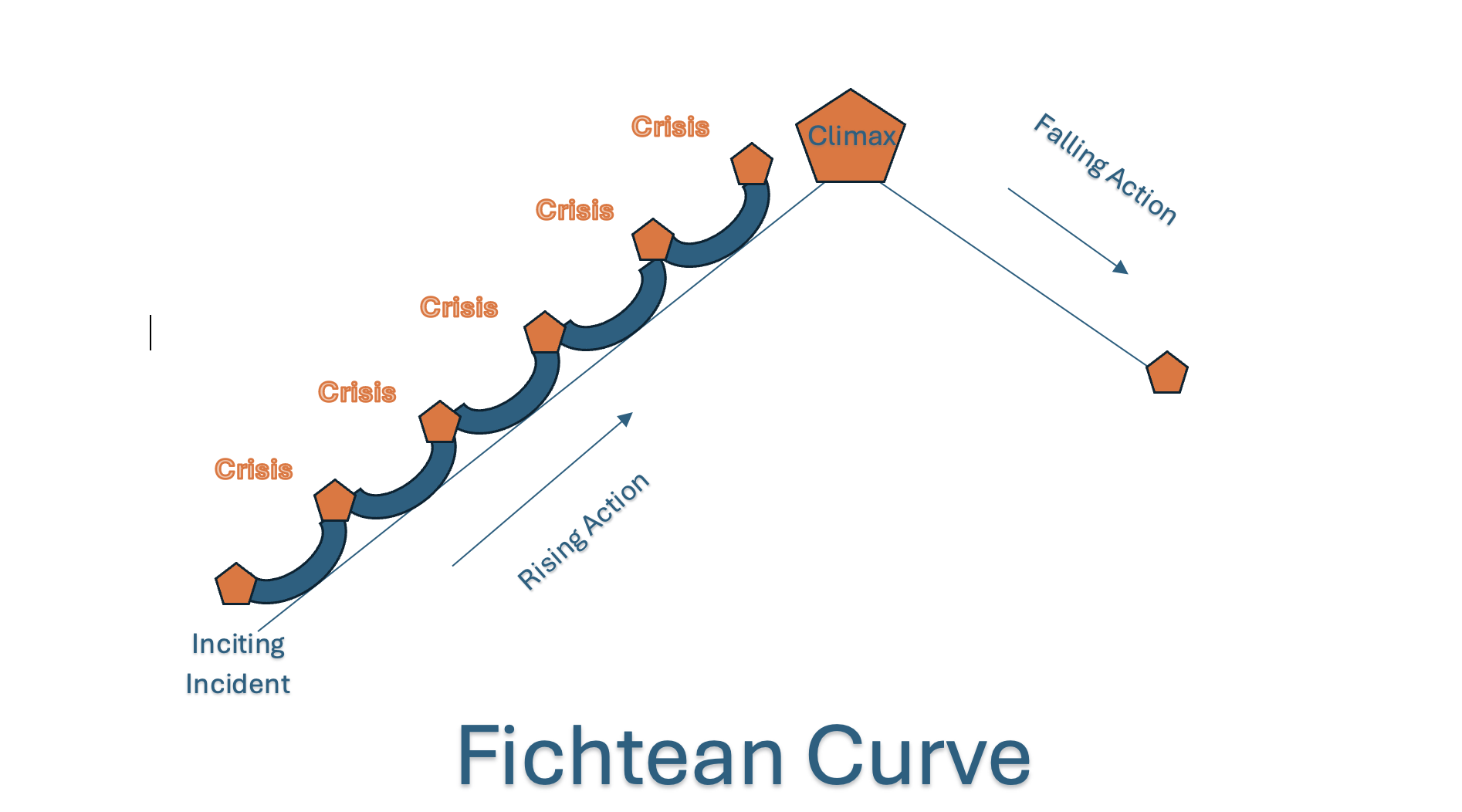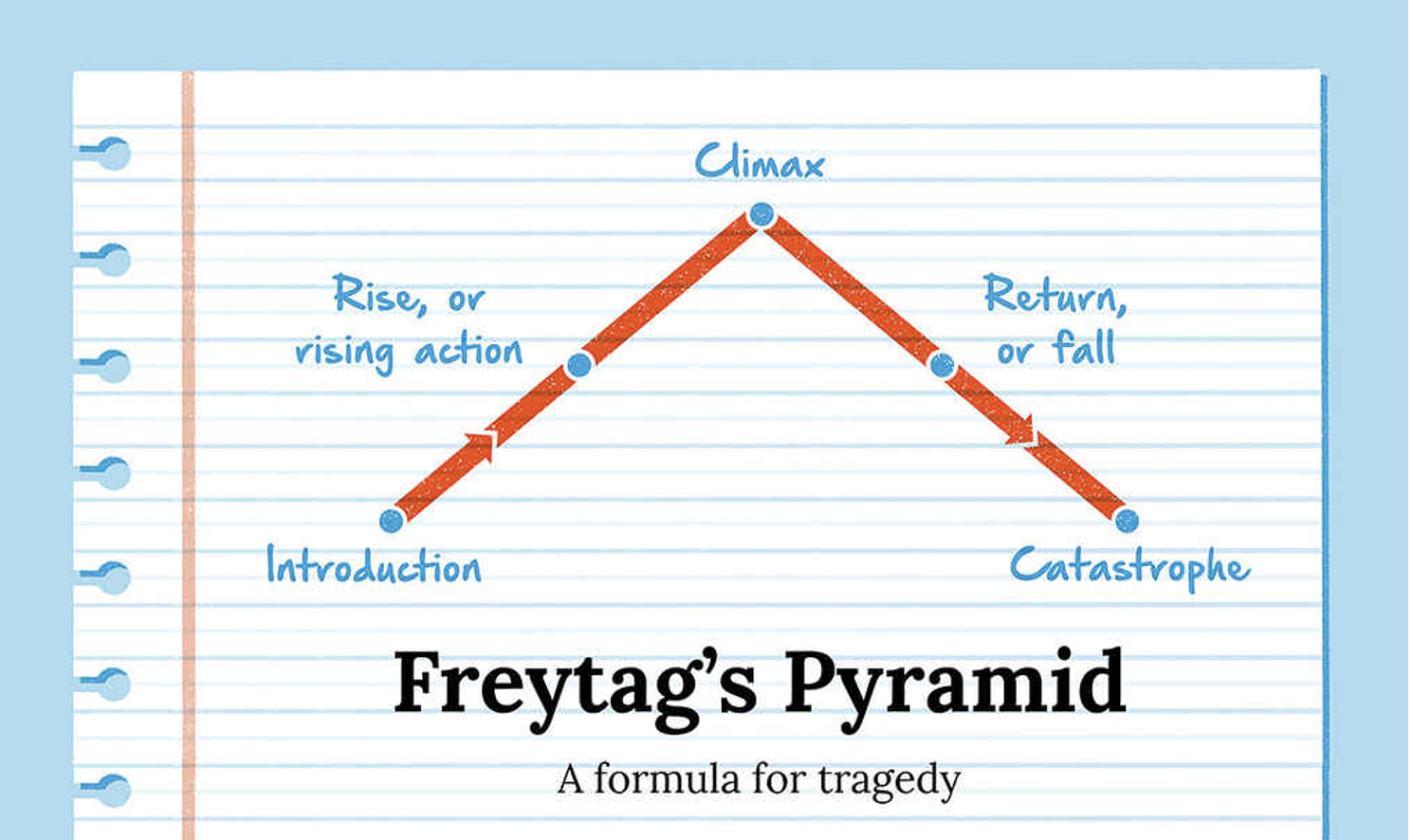Story Structure: Freytag’s Pyramid
Pauline J. Grabia participates in the Amazon Services LLC Associates Program, an affiliate advertising program, and earns from qualifying purchases from links in this post.
Please subscribe to my email newsletter for updates on my website and blog, and exclusive access to exclusive material in the Subscriber Content page of this website (see menu bar above). New content will be added regularly. You can sign up in the form found in the footer of this page. Thank you!
A Brief Review
Last week, we examined story structure and its essential role in storytelling. Story (or narrative) structure is the order in which events in a story are relayed to the reader or audience. It can be thought of as the scaffolding of storytelling, holding the narrative together in a logical sequence or order from the beginning to the end. This week, we will study Freytag’s Pyramid, and the next post will explore the Fichtean Curve.
What is Freytag’s Pyramid?
Freytag’s Pyramid (also known as Freytag’s Triangle) is a narrative structure traditionally used in dramatic storytelling with five distinct elements sections. It was developed by playwright and novelist Gustav Freytag in the 19th century in his work Die Technik des Dramas (Technique of the Drama). It was an overview of the classic five-act plot structure borrowed from Aristotle’s Poetics and Horace’s “Ars Poetica.” It is a derivation from Aristotle’s triangle:
Aristotle’s Triangle
Many myths and classical tragedies follow the five-act structure set out by Freytag, which looks like the following diagram:
Diagram courtesy of Reedsy.com.
As you can see in the diagram, Freytag added two elements to Aristotle’s Triangle—The Rise or Rising Action and The Fall or Falling Action. In total, the five elements include:
1. The Introduction (or Exposition)
2. The Rise or Rising Action
3. The Climax
4. The Fall or Falling Action
5. The Catastrophe (or Conclusion)
The Elements in Detail:
1. Introduction (Exposition): Freytag called this the first act, and in this section of the story, the writer sets up the setting, main characters, and atmosphere/tone. Here, the characters’ backstory is revealed, as well as how the various characters interact and interrelate. The story's stakes are established, and the central conflict is introduced toward the end of this act and the beginning of the next during a pivotal event called the Inciting Incident, which triggers the story into motion.
2. The Rise or Rising Action: Here in the second act, the “rising movement” of the story occurs, where the story gradually builds from obstacle to obstacle thrown in the Protagonist’s path toward a central conflict or climax. New characters, including the Antagonist, are introduced here who add to the conflict and tension. As the plot thickens, tension builds to a fever pitch, and characters develop.
3. Climax: This is the third act. Something signals a turning point. This is the highest point of conflict and tension on the plot structure. It foreshadows the Protagonist’s fate and the events leading to the “Catastrophe” or Conclusion. This series of events is known as the “counterplay,” and they represent external factors that arise from the Protagonist’s choices, which impact them in the remainder of the tale. For better or worse, the Protagonist's fate is decided here.
4. The Fall or Falling Action: In the fourth act, which foreshadows the ultimate outcome of the story, the conflict between the Protagonist and Antagonist comes to a conclusion. There is usually some form of “final suspense” where the fallout or conclusion is not what is expected. Since Freytag focused on tragedies, this is where the Protagonist heads for a tragic outcome. Modern storytelling allows for both happy and unhappy endings.
5. Catastrophe (or Conclusion/Denouement): This is act five, where the story reaches its conclusion and the Protagonist, according to Freytag, meets his or her “moment of catastrophe.” Here, loose ends are tied up, and the storyteller provides the audience with a moment of catharsis, allowing the tension that was built earlier to dissipate. In a tragedy, this is where the final failure occurs. This can be seen in classic Shakespearean tragedies like Hamlet, Othello, and Romeo and Juliet. In stories with an uplifting ending, this is where the “Happily Ever After” occurs.
Freytag’s Updated Pyramid
Modern storytelling has taken Freytag’s Pyramid and adapted it for the stories of today, which include both comedies, tragedies, and everything in between. As a result, over time the original five elements were expanded to six (or for some writers, seven) elements:
Diagram courtesy of ProwritingAid.
1. The Introduction (exposition): Same as the original.
2. Inciting Incident: This was originally part of Freytag’s Introduction, but now it gets its own spot.
3. Rising Action: Same as original.
4. Climax: The turning point, where the action and tension peak and all conflict merges.
5. Falling Action: Includes room for a non-tragic outcome for the story.
6. Resolution: Same as original.
7. Denouement: Seen by some as an epilogue of sorts.
The differences between Freytag’s original pyramid and the updated version are found predominantly in the climax, Catastrophe (Conclusion), and Resolution. For Freytag, the climax was another turning point rather than “the moment we’ve all been waiting for.” Because Freytag focused on tragedies, there would always be a catastrophic event that determined the ending for the Protagonist. For example, in Othello, the murder of Desdemona was the story's climax, but Othello’s consequent suicide was the catastrophe. In the case of a story with a happy ending, like Cinderella, the losing of her glass slipper (climax for Freytag) ends up as a happy “catastrophe” for her (she marries a prince).
Example of the Traditional Freytag Pyramid Structure: Romeo and Juliet by William Shakespeare
One story that is an excellent example of the traditional Freytag Pyramid at work is William Shakespeare’s play, Romeo and Juliet. We will examine the five elements regarding corresponding plot points from the famous tragedy.
1. Introduction (Exposition): Shakespeare introduces the Montagues and the Capulets, two warring families that lived in Verona, Italy. Here, the characters, setting, and conflict are established.
2. Rise or Rising Action: The Star-crossed lovers Romeo (a Montague) and Juliet (a Capulet) meet and fall madly in love. As a result, they rush into a marriage that their feuding families forbid. This fuels a conflict that pushes the plot toward the climax.
3. Climax: Two murders occur, which end up unraveling the young lovers’ matrimonial bliss. Tybalt (Juliet’s cousin) murders Mercutio (Romeo’s friend). In revenge, Romeo kills Tybalt. Romeo’s crime forces the couple to separate and devise a hasty plan to be together.
4. Fall or Falling Action: Rather than proceed with an arranged marriage to someone her father condones, Juliet pretends to commit suicide by drinking a potion that imitates death. She writes a letter to Romeo explaining this to him.
5. Catastrophe or Conclusion: Romeo doesn’t get the note. In grief over Juliet’s apparent death, he drinks poison and dies. When Juliet wakes up and finds Romeo dead, she kills herself with a dagger. The families see the error of their ways and cease their feuding.
The Benefits of Freytag’s Pyramid
Despite being developed in the 19th century and updated since then, this story structure has some definite benefits. They include:
1. It provides a map or blueprint for writers and storytellers.
2. It aids in the organization of conflict progression in a story.
3. It helps a writer in character development.
4. It helps ensure that a story has a distinct rise and fall and that the climax feels earned and authentic.
Still Valid for Today
Freytag’s original pyramid was designed with tragedies in mind since most storytelling up to the 19th century was focused on dramas and tragedy. It has evolved to encapsulate both upbeat and tragic stories. It is a valuable base or tool for beginner writers and other storytellers to get their feet wet using story structure to construct their stories. The next post will examine the story structure type, The Fichtean Curve.
Thank you so much for reading this post and visiting my blog. Please sign up for my newsletter for a monthly update about the website and blog and exclusive access to the material on my Subscriber Content page at www.paulinejgrabia.com. I am honored that you have taken time out of your day to read what I have to offer, and I will endeavor to continue to post blogs that are worthy of your continued attention. May God bless you richly.
Pauline J. Grabia







In previous posts, we have explored various forms of story structure, including Freytag’s Pyramid, the Fichtean Curve, and the Hero’s Journey. Each of these is an effective story structure for a writer, depending on the narrative. The Three-Act Story Structure is one of the most used story frameworks in literature and film. This structure divides the story into three main sections or acts: Act 1, the Setup (or Beginning); Act 2, the Confrontation (or Middle); and Act 3, the Resolution (or Ending). This will not be a comprehensive exploration of the three-act structure, as there are other blogs listed at the end that do a much better job than I could of deeply examining the elements of this structure.